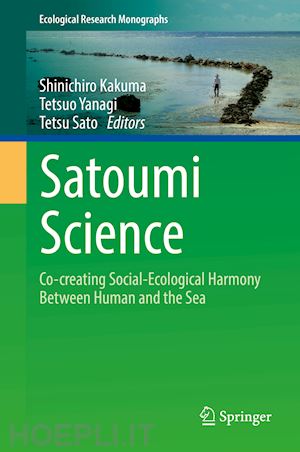
Questo prodotto usufruisce delle SPEDIZIONI GRATIS
selezionando l'opzione Corriere Veloce in fase di ordine.
Pagabile anche con Carta della cultura giovani e del merito, 18App Bonus Cultura e Carta del Docente
The concept of Satoumi goes beyond the idea of protecting pristine nature by eliminating humans. It is about creating coastal environments where humans closely connect with the sea, which leads to the effective conservation and sustainable management of various natural resources and ecosystem services.
This book will be of high interest to managers, governments, environmental groups, and the research community. Chapters cover current and emerging concerns, such as over- and under-use of natural resources, restoration of damaged ecosystems, and co-creation of new relations between humans and coastal seas, from transdisciplinary approaches to tackle with complex and 'wicked' challenges of coastal social-ecological systems.
Shinichiro Kakuma had worked with Okinawa prefectural government for long as a fisheries researcher or extension officer with transdisciplinary approaches. He also studied fisheries co-management and coral reef conservation in 15 Asia-Pacific and Caribbean countries. His interest is Satoumi and marine protected areas. He started the research of Satoumi Science in the early1990s. He moved to Saga University in 2019 and continues his study on Satoumi Science.
Tetsuo Yanagi
Tetsuo Yanagi is a coastal oceanographer with about 500 scientific publications. He was awarded the Japan-France Oceanographic Society Award in 1986 and the Uda-Prize of Oceanographic Society of Japan in 2012. He was a member of the Scientific Steering Committee of Land-Ocean Interactions in the Coastal Zone (LOICZ) and is a member of the Scientific Planning Committee of Japan’s Environmental Management of Enclosed Coastal Seas (EMECS). He discovered the tide-induced residual current and proposed a new concept of Satoumi for integrated coastal sea management.
Project leader of “Establishment of a Sustainable Community Development Model Based on Integrated Natural Resource Management Systems in Lake Malawi National Park” in JICA-JST SATREPS Program.
Tetsu Sato studied the ecology of cichlid fishes of African lakes for 20 years, and he expanded his research into adaptive governance of complex social-ecological systems. Throughout his career, including as Conservation Director of WWF Japan and professor of Research Institute for Humanity and Nature, Kyoto, Japan, he focused on mobilizing creative and transformative processes of innovations based on knowledge co-production. He has been exploring transdisciplinary approach to co-create Integrated Local Environmental Knowledge (ILEK) as the knowledge bases for decision making and collective actions among diverse actors for societal transformations toward sustainable futures.











Il sito utilizza cookie ed altri strumenti di tracciamento che raccolgono informazioni dal dispositivo dell’utente. Oltre ai cookie tecnici ed analitici aggregati, strettamente necessari per il funzionamento di questo sito web, previo consenso dell’utente possono essere installati cookie di profilazione e marketing e cookie dei social media. Cliccando su “Accetto tutti i cookie” saranno attivate tutte le categorie di cookie. Per accettare solo deterninate categorie di cookie, cliccare invece su “Impostazioni cookie”. Chiudendo il banner o continuando a navigare saranno installati solo cookie tecnici. Per maggiori dettagli, consultare la Cookie Policy.